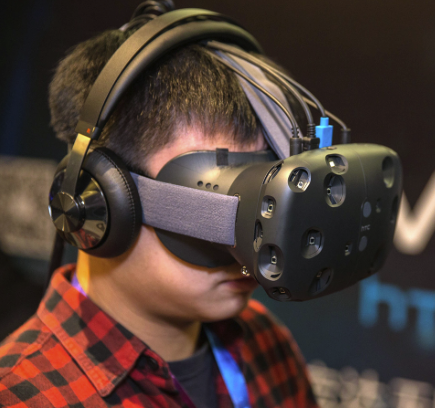If you follow the buzz on the technology street, one of the hottest technologies anticipated at CES this year will be Augmented and Virtual Reality, better known by their AR and VR acronyms. From the future of consumer game console accessories, to high-end B2B car showroom virtual experience, this wearable display technology will be at the upcoming Consumer Electronics Show in full force.

For the record, we covered AR and VR extensively at last Summer’s SIGGRAPH (Special Interest Group Graphics) show in Los Angeles, so just to keep things clear, here is a brief rundown on what was already shown at this ground breaking display event in August 2015, plus some announcements on what we may see that is truly new at CES 2016.
Some milestone events already passed in August 2015 at SigGraph include Nvidia’s Light Field Stereoscope that solves the discomfort and visual fatigue (what the company calls vergence-accommodation conflict) inherent to all stereoscopic displays. Nvidia said that it was showing the first “factored NTE display that supports both high image resolution and focus cues using factored light field synthesis from a pair of stacked LCD (dual) panels”. This approach shows improvements in both resolution and resolution blur quality. The company said contributors included two researchers from Nvidia and Stanford University’s Computational Imaging group.
After almost six years in development, will the Sony Morpheus finally make it to prime time at this year’s CES? Source: SonyNYU has already shown a technology “Holojam” for 3D virtual game play with a fully immersive nomadic VR interaction and real-time position tracking using only the processing power of a Qualcomm Snapdragon mobile processor. It used the Samsung Galaxy Note smartphone / tablet. “We aren’t the first ones showing nomadic real-time 3D rendering with Holojam,” NYU professor and Research Lab director, Dr. Kevin Perlin said, “but we are the first to demonstrate this using off the shelf mobile devices and standard Wi-Fi connectivity”, he said. The team use commodity router and multicast protocol demonstrated working on just commodity phones.
USC’s ICT (Institute for Creative Technologies) demonstrated a first with its nomadic VR environment creating the illusion of “infinite virtual space” within a confined real location. They got there by “hacking human sensitivity” according to Associate Lab Director, Dr. Evan Suma who said his VR demo focused on making small spaces appear bigger in VR. The “Infinite Walking in VR” demo uses the Oculus Rift with 3D tracking and its 9-degrees of freedom plus stop motion animation and 360 images delivered from every angle. Light field rendering, image based rendering and complex visual graphics are employed to achieve a result well beyond what is seen in video games, along with basic polygon crunching.
We also expect to see newer versions of the Viewmaster Mixed Reality Engine based on Vuforia technology originally from Qualcomm at this years CES (Vuforia is now owned by PTC – PTC to Acquire Augmented Reality Leader Vuforia from Qualcomm – Man. Ed.). At SigGraph the company showed a set of Mattel VR Glasses under the Viewmaster brand. This updated next millennium version of the Viewmaster uses a smartphone to power its dual view device much like Google’s Cardboard. Qualcomm’s David Beard said it’s really a “Mixed Reality VR + AR” that transitions information from the real world from objects. It looks like an update of one of those circular film cards from Viewmaster using shape recognition that triggers a VR experience on the inserted smartphone display, that shows images in stereo 3D using the company’s Viewforia software.
 Will the Samsung’s VR headset be looking for traction at CES trade show this year? Source: VenturebeatNew on the horizon at CES, California-based Pantomime is claiming to show the first networked AR VR app that doesn’t require “specialized hardware” using instead the high resolution displays from across Apple iPhones, pads and desktops, and is working on an Android version. The company said its technology app will let any iPad or iPhone user “…look around and reach into physically realistic 3D worlds, using their mobile devices as both immersive 3D viewers and accurate 3D game paddles.”
Will the Samsung’s VR headset be looking for traction at CES trade show this year? Source: VenturebeatNew on the horizon at CES, California-based Pantomime is claiming to show the first networked AR VR app that doesn’t require “specialized hardware” using instead the high resolution displays from across Apple iPhones, pads and desktops, and is working on an Android version. The company said its technology app will let any iPad or iPhone user “…look around and reach into physically realistic 3D worlds, using their mobile devices as both immersive 3D viewers and accurate 3D game paddles.”
HTC announced a new breakthrough to its VIVE technology that may include combined efforts with Kirkland, WA based Valve Corp. technology, according to HTC’s CEO Cher Wang in a recent Engadget story. Osterhout, a San Francisco design house that already showed a $2700 pair of VR goggles in July 2015 is on track for a CES unveiling, along with China based RockChip that has a press release circulating about its newest AR – VR technology that combines its RK3288 processor with a tether-free virtual reality gaming headset that: “…to revolutionize the gamer experience,” according to the company.

HTC Vive, Source IB TimesWe may even get lucky and get a glimpse of the Google Holding Company (Alphabet)-revived Glass prototype, now called Project Aura. It targets “visual and auditory immersion, …next generation theme park experience, but with an eye always on the bottom line, ‘virtual Advertising’,” according to Amigobulls.com web site. Also expect some of the big names in technology like Samsung (Gear VR), Sony (project Morpheus for PS4 prototype) and Oculus Rift plus the other Japan, China and Taiwan brands to either upgrade or enter into the fray. So stay tuned for the upcoming coverage as the world turns to VR and AR live from the desert sand of Las Vegas. – Steve Sechrist

